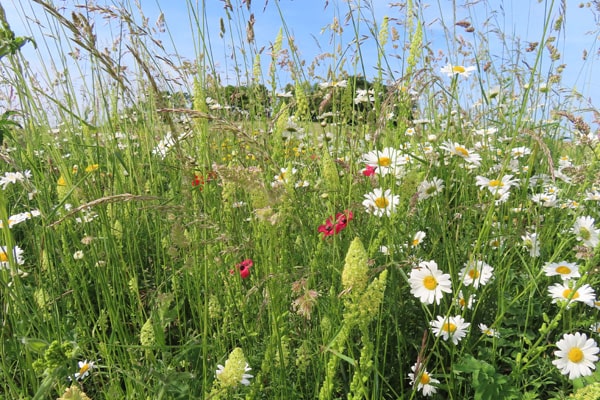About
On Magog Down you can walk by meadows yellow with cowslips in spring, then dazzling white in early summer with ox-eye daisies. Woods skirt the edges of the meadows, cool and shady in summer. Pillows of blossom from the blackthorn and hawthorn fill the hedges in spring. The wide expanse of hillside is great for children to fly their kites or sledge down in winter when there is snow.

On these hillsides, it is likely that Charles Darwin carried out botanical field studies when a student at Cambridge. Records show that his mentor, John Henslow, did so. Across the year, you can see scabious, orchids, wild marjoram, wild thyme all signature species of precious chalk grassland. There is an immense variety of birdlife; skylarks, whitethroat, charms of goldfinch; fieldfare and redwing in winter to name a few.
There are picnic tables near the car park or you can spread a rug on the grass and enjoy the views. The spires of King’s College Chapel can be spotted along with the University Library and Great St Mary’s Church, contrasting with the modern buildings of the Biomedical Campus in the immediate foreground.

Further back, in Neolithic times, humans gathered on this hillside within a causewayed enclosure and there is a Bronze Age Bowl Barrow on the hilltop, as on many nearby locations. A public footpath crosses the site and links up with Wandlebury Country Park by crossing the A1307, from where you can reach the Roman Road.

History of Magog Down
In February 1989, a ‘For Sale’ sign appeared in one corner of a hilly field and an article concerning its sale was published in the Cambridge Evening News by local journalist, Christopher South. These were spotted by local builder, Ray Barnes, and discussed with Colin Davison, vicar of Stapleford, and were the starting point for a project to buy the land (164 acres/66 hectares) and make it available for public access, recreation and conservation. Within four months, a group of volunteers had established a new company and charity, The Magog Trust. Rapid fundraising was essential and, over the next three months, supported by the Cambridge Evening News, the purchase price of £327,000 was achieved via a combination of grants, loans, donations from public bodies, local councils, local companies and individuals. The latter were able to purchase ‘Gogs’ (notional pieces of land). Finally, on 29 September 1989, the land was purchased and the task of restoring the site to the chalk downland you see today could begin.
Read more
Archaeology on Magog Down
The highest point on Magog Down, Little Trees Hill (74m), part of the Gog Magog Hills, lies on Cretaceous Lower Chalk, having a glacial covering of boulder clay with underlying gravel currently excavated by badgers. Aerial photography (taken at various times from the 1950s through to 1984) has confirmed the existence of a causewayed enclosure encircling Little Trees Hill on the 65m contour, which has been dated to the Middle Neolithic period (3000-2400 BCE). Further archaeological surveys have shown that a Bronze Age Bowl Barrow is present near the summit of Little Trees Hill (formerly Clunch Pit Hill). As a result, this area was scheduled as an Ancient Monument by English Heritage in 1994.

The local area has been grassland probably since prehistoric times and was famous for extensive sheep walks until well into the 19th century. There are records of sheep grazing back to the 13th century. Enclosure in 1812 resulted in a progressive change of land use from grassland to arable crops, although sheep never disappeared entirely. The Farmland page tells you more about how the land is farmed today.
Clunch pits dug into the chalk landscape are a common feature in this part of South Cambridgeshire. The extracted clunch was used locally as a building material. There was a large quarry on Little Trees Hill and Stapleford Parish Pit adjoins the site. The latter was used until the 1930s. Following restoration, this pit is now a haven for wildlife and flowers, including many chalk indicator species.
Trust Management & Finances
As mentioned above, The Magog Trust is a registered charity (established in 1989). Its overriding objective and principal activity is the restoration and subsequent conservation of its land at Magog Down to chalk pasture and woodland, which is open to the public for access and recreation.
A group of Trustee Directors meet regularly to oversee and manage the affairs of the Trust. There is one part-time member of staff who is responsible for day-to-day administration of the charity. All work on the land is carried out by contractors or by volunteers.
The annual running costs are around £75,000. Income to cover these costs comes from various sources – Friends’ subscriptions, car parking fees, farming, land grants and income from the investment fund.
Further information on the charity and its finances (including access to the latest Annual Report and Accounts) are available by clicking the link below.
Gallery
We know that many of you take photographs when you visit Magog Down. We are always pleased to receive copies of visitor’s images, which may be featured on the Gallery page or elsewhere on the website.
Please submit your photos using the button below.
Contact Us
For ways of getting in touch with the Trust or to send a message, please use the link below.



